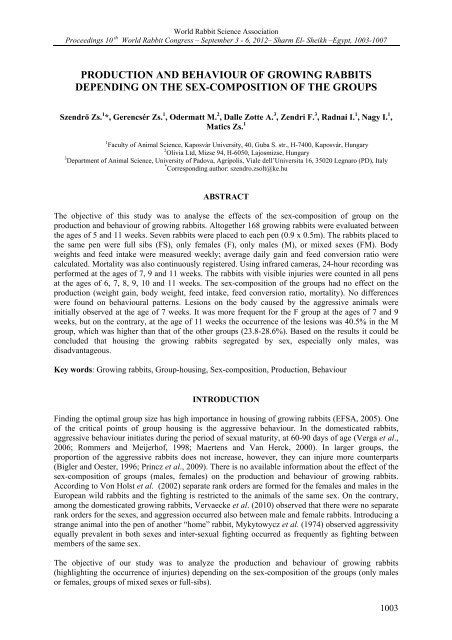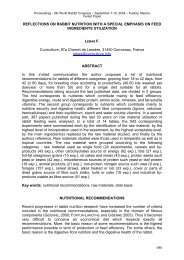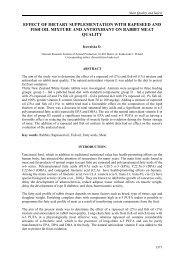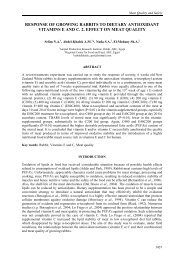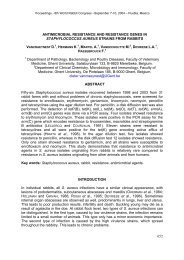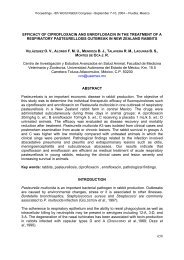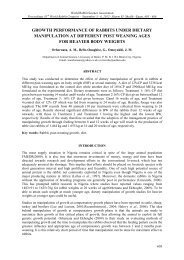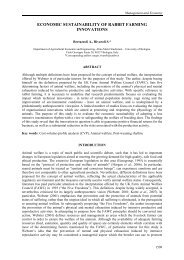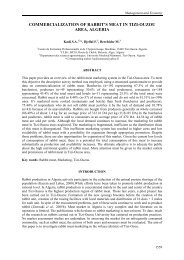Szendrö Zs. - World Rabbit Science Association
Szendrö Zs. - World Rabbit Science Association
Szendrö Zs. - World Rabbit Science Association
Create successful ePaper yourself
Turn your PDF publications into a flip-book with our unique Google optimized e-Paper software.
<strong>World</strong> <strong>Rabbit</strong> <strong>Science</strong> <strong>Association</strong><br />
Proceedings 10 th <strong>World</strong> <strong>Rabbit</strong> Congress – September 3 - 6, 2012– Sharm El- Sheikh –Egypt, 1003-1007<br />
PRODUCTION AND BEHAVIOUR OF GROWING RABBITS<br />
DEPENDING ON THE SEX-COMPOSITION OF THE GROUPS<br />
Szendrő <strong>Zs</strong>. 1 *, Gerencsér <strong>Zs</strong>. 1 , Odermatt M. 2 , Dalle Zotte A. 3 , Zendri F. 3 , Radnai I. 1 , Nagy I. 1 ,<br />
Matics <strong>Zs</strong>. 1<br />
1 Faculty of Animal <strong>Science</strong>, Kaposvár University, 40, Guba S. str., H-7400, Kaposvár, Hungary<br />
2 Olivia Ltd, Mizse 94, H-6050, Lajosmizse, Hungary<br />
3 Department of Animal <strong>Science</strong>, University of Padova, Agripolis, Viale dell’Universita 16, 35020 Legnaro (PD), Italy<br />
* Corresponding author: szendro.zsolt@ke.hu<br />
ABSTRACT<br />
The objective of this study was to analyse the effects of the sex-composition of group on the<br />
production and behaviour of growing rabbits. Altogether 168 growing rabbits were evaluated between<br />
the ages of 5 and 11 weeks. Seven rabbits were placed to each pen (0.9 x 0.5m). The rabbits placed to<br />
the same pen were full sibs (FS), only females (F), only males (M), or mixed sexes (FM). Body<br />
weights and feed intake were measured weekly; average daily gain and feed conversion ratio were<br />
calculated. Mortality was also continuously registered. Using infrared cameras, 24-hour recording was<br />
performed at the ages of 7, 9 and 11 weeks. The rabbits with visible injuries were counted in all pens<br />
at the ages of 6, 7, 8, 9, 10 and 11 weeks. The sex-composition of the groups had no effect on the<br />
production (weight gain, body weight, feed intake, feed conversion ratio, mortality). No differences<br />
were found on behavioural patterns. Lesions on the body caused by the aggressive animals were<br />
initially observed at the age of 7 weeks. It was more frequent for the F group at the ages of 7 and 9<br />
weeks, but on the contrary, at the age of 11 weeks the occurrence of the lesions was 40.5% in the M<br />
group, which was higher than that of the other groups (23.8-28.6%). Based on the results it could be<br />
concluded that housing the growing rabbits segregated by sex, especially only males, was<br />
disadvantageous.<br />
Key words: Growing rabbits, Group-housing, Sex-composition, Production, Behaviour<br />
INTRODUCTION<br />
Finding the optimal group size has high importance in housing of growing rabbits (EFSA, 2005). One<br />
of the critical points of group housing is the aggressive behaviour. In the domesticated rabbits,<br />
aggressive behaviour initiates during the period of sexual maturity, at 60-90 days of age (Verga et al.,<br />
2006; Rommers and Meijerhof, 1998; Maertens and Van Herck, 2000). In larger groups, the<br />
proportion of the aggressive rabbits does not increase, however, they can injure more counterparts<br />
(Bigler and Oester, 1996; Princz et al., 2009). There is no available information about the effect of the<br />
sex-composition of groups (males, females) on the production and behaviour of growing rabbits.<br />
According to Von Holst et al. (2002) separate rank orders are formed for the females and males in the<br />
European wild rabbits and the fighting is restricted to the animals of the same sex. On the contrary,<br />
among the domesticated growing rabbits, Vervaecke et al. (2010) observed that there were no separate<br />
rank orders for the sexes, and aggression occurred also between male and female rabbits. Introducing a<br />
strange animal into the pen of another “home” rabbit, Mykytowycz et al. (1974) observed aggressivity<br />
equally prevalent in both sexes and inter-sexual fighting occurred as frequently as fighting between<br />
members of the same sex.<br />
The objective of our study was to analyze the production and behaviour of growing rabbits<br />
(highlighting the occurrence of injuries) depending on the sex-composition of the groups (only males<br />
or females, groups of mixed sexes or full-sibs).<br />
1003
Ethology, Housing &Welfare<br />
Animals and experimental design<br />
MATERIALS AND METHODS<br />
The analysis was conducted at the rabbit farm of Kaposvár University using the maternal line of the<br />
Pannon rabbit breeding programme. <strong>Rabbit</strong>s (n=168) were weaned at the age of 5 weeks and housed in<br />
open top wire net pens having a basic area of 0.9 x 0.5 m (16 rabbitsl/m 2 ). Each pen was equipped<br />
with a 30 cm long feeder and two nipple drinkers. The daily lighting period was 16 hours with an<br />
intensity of 50-80 Lux, while the temperature ranged between 15-19°C. The rabbits received<br />
commercial diets (5-9 weeks of age: 10.3 MJ DE/kg, 14.5% crude protein, 17.5% crude fibre; 9-11<br />
weeks of age: 10.6 MJ DE/kg, 16% crude protein, 16% crude fibre).<br />
In the 24 pens 4 groups were formed:<br />
M = 7 males per pen,<br />
F = 7 females per pen,<br />
MF = 3-4 males and 3-4 females per pen (not full-sibs),<br />
FS = 7 full-sibs per pen (mixed gender).<br />
Body weights and feed intake (per pen) were measured weekly. Average daily gain and feed<br />
conversion ratio were calculated. Mortality was also continuously registered.<br />
Using infrared cameras, 24-hour recordings were performed at the ages of 7, 9 and 11 weeks. During<br />
these days nobody entered the rooms in order not to disturb the rabbits’ behaviour. Analysing the<br />
recordings the actual behaviour of the rabbits were registered at every half an hour (sampling method).<br />
Then the proportions of every behaviour patterns were calculated. The rabbits with visible injuries<br />
were counted in all pens at the ages of 6, 7, 8, 9, 10 and 11 weeks. Wounds on the rabbits’ ears (holes<br />
or scratches originating from biting) or on other body parts were considered as injuries.<br />
Statistical Analysis<br />
Productive data and the occurrence of the different behaviour patterns were analysed by means of one<br />
and two factor analysis of variance (age, group sex-composition). For average daily gain and body<br />
weight the rabbit was the experimental unit, while for feed intake and feed conversion ratio the pens<br />
were considered as experimental units. Occurrence of lesions was analysed by means of one factor<br />
analysis of variance. Mortality was evaluated by Chi 2 -test. All statistical analyses were performed<br />
using SPSS10.0 software package.<br />
RESULTS AND DISCUSSION<br />
Productive traits are summarized in Table 1.<br />
No significant differences were observed in any trait, because there is no, or insignificant sexual<br />
dimorphism until slaughtering (Lebas et al., 1986). Based on the results production of the growing<br />
rabbits was not influenced by the sex-composition of the groups, and housing full-sibs gave no<br />
improvement. Any sign of aggression was not found on the 3 dead rabbits in group F.<br />
Table 1: Effect of sex-composition of groups on productive performance of growing rabbits<br />
Traits<br />
Groups<br />
Littermates Females Males Females & Males<br />
SE Prob.<br />
<strong>Rabbit</strong>s, no. 42 42 42 42<br />
Weight gain (g/d) 39.3 38.4 35.7 39.1 0.35 0.781<br />
Live weight 11 wk (g) 2610 2569 2582 2599 17.1 0.843<br />
Feed intake ( g/d) 129 123 125 126 1.5 0,706<br />
Feed conversion 3.27 3.24 3.23 3.25 0.03 0.942<br />
Mortality (%) 0.0 7.1 0.0 0.0 NS<br />
1004
10 th <strong>World</strong> <strong>Rabbit</strong> Congress – September 3 - 6, 2012– Sharm El- Sheikh –Egypt<br />
Frequencies of the behavioural patterns depending on the sex-composition of groups are shown in<br />
Table 2.<br />
Table 2: Effect of sex-composition of groups on behavioural patterns of growing rabbits<br />
(Means of ages at 7, 9 and 11 weeks)<br />
Groups<br />
Behavioural patterns<br />
SE<br />
Littermates Females Males Females & males<br />
Eating (%) 10.13 10.38 9.71 9.81 0.18 0.373<br />
Drinking (%) 2.05 2.08 1.63 1.93 0.07 0.144<br />
Resting (%) 64.56 65.06 63.33 65.34 0.37 0.291<br />
Moving (%) 2.35 2.08 2.59 2.74 0.11 0.085<br />
Comfort (%) 14.19 14.22 13.54 14.03 0.31 0.648<br />
Social (%) 3.44 2.64 3.31 3.26 0.14 0.188<br />
Exploration (%) 3.17 3.24 2.57 2.53 0.14 0.120<br />
Aggressive (%) 0.14 0.31 0.32 0.40 0.08 0.569<br />
Prob.<br />
Sex-composition of groups had no effect on the growing rabbits’ behaviour for the active (23:00 and<br />
5:00 hours), resting (11:00 and 17:00 hours) and the total (00:00 and 24:00 hours) periods.<br />
The effect of age was significant at several occasions (data are not shown). Higher occurrence rates<br />
were observed for eating, drinking and moving for the 7 week old rabbits compared to that of the 11<br />
week old animals (P
Ethology, Housing &Welfare<br />
Occusions<br />
10<br />
9<br />
8<br />
7<br />
6<br />
5<br />
4<br />
3<br />
2<br />
1<br />
0<br />
22-23<br />
0-1<br />
2-3<br />
Dark<br />
4-5<br />
6-7<br />
8-9<br />
10-11<br />
Light<br />
12-13<br />
Hours of the day<br />
Figure 1: Occurrence of aggressive behaviour among growing rabbits during the day<br />
14-15<br />
16-17<br />
18-19<br />
20-21<br />
Justifying our previous findings (Princz et al., 2009), no aggressive behaviour was detectable during<br />
the resting period. Increasing aggression was the most frequently observed during the transition<br />
periods (when switching on or off the light). This finding is in accordance with the observation that the<br />
European wild rabbits are most active at dawn and at sunset (Jilge, 1991).<br />
CONCLUSIONS<br />
Based on the results it can be concluded that group housing rabbits of the same sex had no advantage<br />
from the viewpoint of production, on the contrary, the occurrence of aggressive behaviours and related<br />
inquires became more frequent.<br />
AKNOWLEDGEMENT<br />
Financial help of TECH_08_A3/2-2008-0384, NDA (National Development Agency) and TÉT<br />
(OMFB-00358/2008) are gratefully acknowledged.<br />
REFERENCES<br />
Bigler L., Oester H. 1996. Group housing for male rabbits.In: Proc. 6 th <strong>World</strong> <strong>Rabbit</strong> Congress. 1996. Toulouse, Vol.2, 411-<br />
415.<br />
EFSA (European Food and Safety Authority) 2005. Scientific report „The impact of the current housing and husbandry<br />
systems on the health and welfare of farmed domestic rabbit”, EFSA-Q-2004-023, EFSA Journal 267, 1-<br />
137.MORTON<br />
Jilge B. 1991. The rabbit: a diurnal or a nocturnal animal? Journal of experimental animal science. 34: 170-183.<br />
Maertens L., Van Herck A. 2000. Performance of weaned rabbits raised in pens or in classical cages: first results. <strong>World</strong><br />
<strong>Rabbit</strong> Sci. 8 (suppl. 1), 435-440.<br />
Mykytowycz R., Hesterman E.R., Dudzinski, M.L., Edwards, C.B.H. 1974. An experimental study of aggression in cxaptive<br />
European rabbits, Oryctolagus Cuniculus (L.). Behaviour, 52, 104-123.<br />
1006
10 th <strong>World</strong> <strong>Rabbit</strong> Congress – September 3 - 6, 2012– Sharm El- Sheikh –Egypt<br />
Princz Z., Dalle Zotte A., Metzger Sz., Radnai I., Biró-Németh E., Orova Z., Szendrő <strong>Zs</strong>. 2009. Response of fattening rabbits<br />
reared under different housing conditions. 1. Live performance and health status. Livest. Sci. 121, 86-91.<br />
Rommers J.M., Meijerhof R. 1998. Effect of group size on performance, bone strength and skin lesions of meat rabbits,<br />
housed under commercial condition. <strong>World</strong> <strong>Rabbit</strong> Sci. 6, 199-302.<br />
Varvaecke H., De bonte L., Maertens L., Tuyttens F., Stevens J.M.G., Lips D. 2010. Development of hierarchy and rank<br />
effects in weaned fattening rabbits (Oryctolagus cuniculus). <strong>World</strong> <strong>Rabbit</strong> Sci.<br />
Verga M., Luzi F., Szendrő <strong>Zs</strong>. 2006. Behaviour of growing rabbits. In: Maertens, L., Coudert, P. (Eds): Recent advances in<br />
rabbit sciences. ILVO, Melle, Belgium, 91-97.<br />
1007


